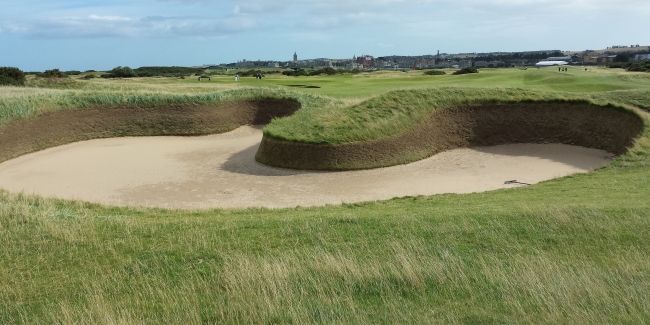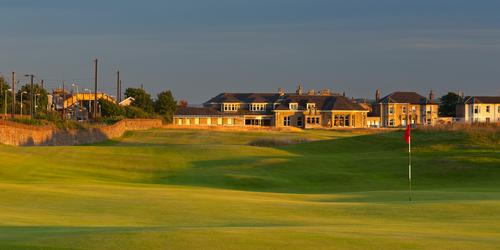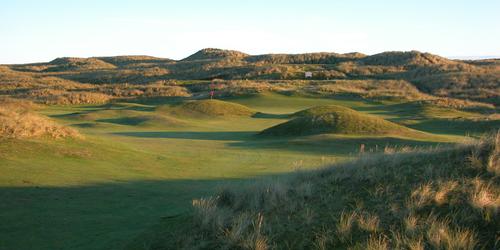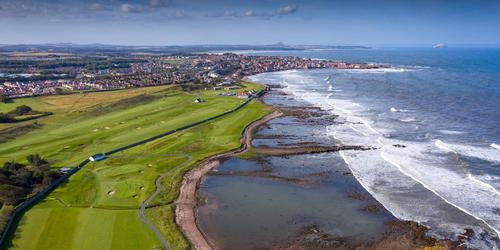
The Sands of St. Andrews
Best Seen, But Not Experienced
By Mike May
Have you ever been in the Lion's Mouth? Have you ever visited The Coffins? How about Hell? If not, then it's unlikely that you've played golf at the historic Old Course at St. Andrews, located along Scotland's east coast. While many golf courses name their holes, St. Andrews has the wherewithal to also name its sand bunkers. And, if you play the Old Course at St. Andrews, one of your shots is likely to land in one of its 112 sand traps which have rather unique names like Shell, Strath, Road Hole, The Principal's Nose, The Spectacles, The Coffins, Lion's Mouth, and Hell, to name just a few. Of course, if you successfully navigate the sand traps at St. Andrews, which appear on 16 of the holes, you also must avoid the Swilcan Burn on the 1st hole and the Valley of Sin at the 18th hole.
The great thing about the Old Course at St. Andrews is that golfers get a first-hand look at the bunkers on Monday through Saturday while playing the course. Then, the general public (and non golfers) can enjoy a glimpse at St. Andrews' bunkers on the Sabbath. On Sundays, the Old Course is closed to golf. Instead, the course is transformed into a public park where people can have a picnic, walk their dogs, throw a Frisbee, or have a nap while lying on a blanket in the fairway -- while staying off the greens and out of the sand bunkers. The only time when the Old Course is used for golf on a Sunday is when a significant tournament - such as an Open Championship - is held on the premises.
On all golf courses, bunkers are a hazard. At St. Andrews, the bunkers take center-stage because the course's biggest defense are the wind and those sand pits. The bunkers at St. Andrews range in size from the many miniscule pot bunkers to the massive Hell bunker on the par-5 14th hole. While the Hell bunker is the biggest sand trap on the course - six-and-a-half feet deep and covering more than 300 square yards - it is probably the course's second most famous (and feared) sand trap. The Road Hole bunker, which borders the 17th green, is the most famous bunker at the Old Course. And, actually, it is one of the most feared sand traps in all of Great Britain. More on that bunker in a moment.
To help bring Hell bunker up to speed for the 2015 British Open, it was updated with new sod faces and more than 60 tons of new sand. That was no easy task.
"Rebuilding such a vast bunker differs from the others on the course," says greenkeeper Martin Turna.
Hell Bunker is a hazard which golfers should avoid at all costs. Case in point: Back in 1933, Gene Sarazen was defending his title at the Open Championship (aka, British Open), which was being played at St. Andrews. In one of the rounds, Sarazen's ball landed in Hell bunker. By the time he holed out and walked off the 14th green, he had a triple bogey 8 and missed being in a playoff for the Open Championship by one shot.
At the 1978 British Open, the Road Hole bunker reared its ugly head at Japan's Tsuneyuki 'Tommy' Nakajima. In the third round, Nakajima was tied for the lead when he teed off on the 17th hole. After reaching the green in two, Nakajima's first putt was struck and rolled off the green, eventually finishing in the Road Hole bunker. Four shots later, his ball was back on the putting surface. The Road Hole bunker earned a new nickname that day: 'The Sands of Nakajima.' Nakajima never threatened the lead at the '78 Open after that debacle, which resulted in a quintuple bogey 9.
There are other famous bunkers at the Old Course. Here are a few short takes:
As you play the par five 5th hole, you'll notice The Spectacles -- two pot bunkers situated about 50-60 yards short of the putting surface. One of the bunkers is on the left side of the fairway and the other one is on the right side of the fairway. They are virtually identical. If your second shot finishes in The Spectacles, you have a 50 percent chance of reaching the green with your third shot.
The toughest of the par threes at the Old Course is the 11th hole. It is made more difficult by the presence of the Shell and Strath bunkers which protect the entrance to the green. Tee shots that land in the Shell bunker will present you with the toughest shot in golf - the long bunker shot to the green. Any tee shot that finishes in the Strath bunker can sometimes result in a plugged or unplayable lie. Always take enough club to clear both the Shell and Strath bunkers.
In the middle of the 13th fairway, just under 300 yards from the tee, are The Coffin bunkers - three of them. The Coffins are situated side-by-side across the fairway. The Coffins intersect with the direct line from the tee to the green. You either go over The Coffins, lay up short of them, drive up the right side (where you can use the 6th fairway), or you go around them on the left. If your tee shot finishes in The Coffins, getting on the green in two is not possible.
If you avoid The Coffins, you will then get to negotiate the Lion's Mouth bunker which guards the 13th green, the largest putting surface (a double green) at St. Andrews.
When you play the par four 15th, while there are three fairway pot bunkers known as the Rob's that you must avoid, what's interesting about this hole is the line of sight that you should follow from the tee. On your tee shot, aim for the church steeple in the distance and make sure that your tee shot splits the two fairway humps known as Miss Grainger's bosoms!
The 16th hole is best played up the right side of the fairway, but out of bounds lingers on the right side as do the three Principal's Nose pot bunkers. And, just past the Principal's Nose bunkers, you will find another diabolic sand trap, Deacon's Sime, which is named after a local preacher who played many rounds of golf at the Old Course during his life. During his lifetime, the preacher noted that the bunker should be named after him, upon his death. Why? He allegedly spent so much time in that bunker when he played the Old Course, that he felt it would be appropriate for his ashes to be deposited in the bunker so that he could spend eternity in that specific hazard.
To better understand the penal nature of St. Andrews' sand traps, get a first-person perspective.
"I did hit my ball into a couple of them (bunkers), but not the Road Hole bunker or Hell bunker," recalls Bob Koepka of Lake Worth, Florida who played in the pro-am of the European PGA Tour's Alfred Dunhill Links Championship at the Old Course in the fall of 2015 with his son Brooks Koepka, a current member of the PGA Tour. "My ball landed in one bunker on the 9th hole that ended up so close to the side that it was almost impossible to even get a club on it as it ended up about three inches from the wall. At the Old Course, you cannot see them (the bunkers) from the tee."
"It is the small ones (bunkers) that tend to get you as they are harder to see off the tee," notes Neil Hodding of Carbis Bay, Cornwall, England, who has played the Old Course many times. "If your ball ends up in one of the fairway bunkers, then take your medicine and simply get out. Leave ambition behind as the result will more likely be a double bogey than a par save."
In addition to the unique names given to some of the bunkers at St. Andrews, each hole at the Old Course has a distinct name. It all starts with the Burn (1st hole), the 9th hole is appropriately called End, the back nine begins with Bobby Jones (10th hole), and your round finishes with Tom Morris (18th hole). Oh, and the majority of the putting surfaces at the Old Course also happen to be double greens so make sure that you aim for the correct pin!
It's fair to say that when playing the Old Course at St. Andrews, the best way to remember the bunkers is to avoid hitting into them. In other words, they are best seen, but not experienced. And please remember that, at St. Andrews, it's possible to go to Hell and back in one day without having to die. And you can pay for it with a credit card!
Revised: 09/29/2016 - Article Viewed 32,944 Times
About: Mike May
 Mike May is a Wellington, Florida-based freelance golf and sportswriter, who is also a 25+ year public relations and communications executive in the sporting goods industry. He is also a veteran high school soccer official, an experienced high school basketball coach, an avid athlete, a part-time personal trainer, and a passionate golfer who is forever in pursuit of Old Man Par. He is a member of the Golf Writers Association of America.
Mike May is a Wellington, Florida-based freelance golf and sportswriter, who is also a 25+ year public relations and communications executive in the sporting goods industry. He is also a veteran high school soccer official, an experienced high school basketball coach, an avid athlete, a part-time personal trainer, and a passionate golfer who is forever in pursuit of Old Man Par. He is a member of the Golf Writers Association of America.
Follow Mike May:
Contact Mike May:
GolfTrips.com - Contributor
















